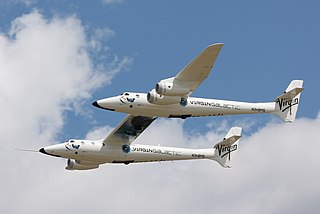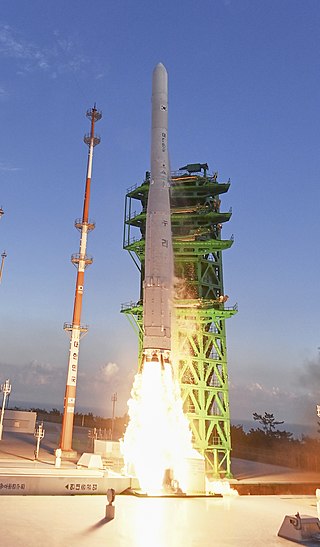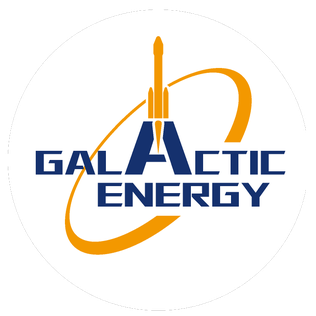
Ariane 5 is a retired European heavy-lift space launch vehicle developed and operated by Arianespace for the European Space Agency (ESA). It was launched from the Guiana Space Centre (CSG) in French Guiana. It was used to deliver payloads into geostationary transfer orbit (GTO), low Earth orbit (LEO) or further into space. The launch vehicle had a streak of 82 consecutive successful launches between 9 April 2003 and 12 December 2017. Since 2014, Ariane 6, a direct successor system, first launched in 2024.

Virgin Galactic Holdings, Inc. is a British-American spaceflight company founded by Richard Branson and the Virgin Group conglomerate which retains an 11.9% stake through Virgin Investments Limited. It is headquartered in California, and operates from New Mexico. The company develops commercial spacecraft and provides suborbital spaceflights to space tourists. Virgin Galactic's suborbital spacecraft are air launched from beneath a carrier airplane known as White Knight Two. Virgin Galactic's maiden spaceflight occurred in 2018 with its VSS Unity spaceship. Branson had originally hoped to see a maiden spaceflight by 2010, but the date was delayed, primarily due to the October 2014 crash of VSS Enterprise.

The Scaled Composites Model 339 SpaceShipTwo (SS2) was an air-launched suborbital spaceplane type designed for space tourism. It was manufactured by The Spaceship Company, a California-based company owned by Virgin Galactic.

The Scaled Composites Model 348 White Knight Two (WK2) is a quadjet cargo aircraft that was used to lift the SpaceShipTwo (SS2) spacecraft to release altitude. It was developed by Scaled Composites from 2007 to 2010 as the first stage of Tier 1b, a two-stage to suborbital-space crewed launch system. WK2 is based on the successful mothership to SpaceShipOne, White Knight, which itself was based on Proteus.

Falcon 9 is a partially reusable, human-rated, two-stage-to-orbit, medium-lift launch vehicle designed and manufactured in the United States by SpaceX. The first Falcon 9 launch was on 4 June 2010, and the first commercial resupply mission to the International Space Station (ISS) launched on 8 October 2012. In 2020, it became the first commercial rocket to launch humans to orbit. The Falcon 9 has an exceptional safety record, with 378 successful launches, two in-flight failures, one partial failure and one pre-flight destruction. It is the most-launched American rocket in history.

Long March 5, or Changzheng 5 (CZ-5), and also by its nickname "Pang-Wu", is a Chinese heavy-lift launch vehicle developed by the China Academy of Launch Vehicle Technology (CALT). It is the first Chinese launch vehicle designed to use exclusively non-hypergolic liquid propellants. It is the fifth iteration of the Long March rocket family.

Soyuz 2 is a modernized expendable medium-lift launch vehicle and the seventh major version of the Soyuz rocket family. It includes key enhancements over its predecessors including improved engines along with digital flight control and telemetry systems, enabling launches from fixed platforms and the use of large payload fairings.

Rocket Lab USA, Inc. is a publicly traded aerospace manufacturer and launch service provider. Its Electron orbital rockets launches small satellites, and has launched 53 times as of 2024. A sub-orbital Electron variant called HASTE serves other needs. The company also supplies satellite components including star trackers, reaction wheels, solar cells and arrays, satellite radios, separation systems, as well as flight and ground software.

Falcon Heavy is a heavy-lift launch vehicle with partial reusability that can carry cargo into Earth orbit, and beyond. It is designed, manufactured and launched by American aerospace company SpaceX.

Nuri, also known as KSLV-II, is a three-stage launch vehicle, the second one developed by South Korea and the successor to Naro-1 (KSLV-1). Nuri is developed by Korea Aerospace Research Institute (KARI). All three stages use indigenously developed launch vehicle engines, making Nuri the first indigenously developed South Korean orbital launch vehicle.

Firefly Aerospace is an American private aerospace firm based in Cedar Park, Texas, that develops small and medium launch vehicles for commercial launches to orbit. The company completed its $75 million Series A investment round in May 2021, which was led by DADA Holdings. The current company was formed when the assets of the former company Firefly Space Systems were acquired by EOS Launcher in March 2017, which was then renamed Firefly Aerospace. Firefly's stated purpose is to increase access to space, similar to other private spaceflight companies.

Electron is a two-stage, partially reusable orbital launch vehicle developed by Rocket Lab, an American aerospace company with a wholly owned New Zealand subsidiary. Electron services the commercial small satellite launch market. It's the third most launched small-lift launch vehicle in history. Its Rutherford engines are the first electric-pump-fed engine to power an orbital-class rocket. Electron is often flown with a kickstage or Rocket Lab's Photon spacecraft. Although the rocket was designed to be expendable, Rocket Lab has recovered the first stage twice and is working towards the capability of reusing the booster. The Flight 26 (F26) booster has featured the first helicopter catch recovery attempt. Rocket Lab has, however, abandoned the idea of catching Electron.

Vulcan Centaur is a heavy-lift launch vehicle created and operated by United Launch Alliance (ULA). It is a two-stage-to-orbit launch vehicle consisting of the Vulcan first stage and the Centaur second stage. It replaces ULA's Atlas V and Delta IV rockets. It is principally designed for the National Security Space Launch (NSSL) program, which launches satellites for U.S. intelligence agencies and the Defense Department, but ULA also believes it will be able to price missions low enough to attract commercial launches.

Spirit of Mojave, previously Cosmic Girl is a Boeing 747-400 aircraft. A former passenger airliner operated by Virgin Atlantic, it was purchased by Virgin Galactic in 2015 to be used as the first stage launch platform for the air launch stage of the smallsat orbital launch vehicle, the LauncherOne. In 2017, the aircraft was transferred to the orbital launch subsidiary, Virgin Orbit, and its livery updated to Virgin Orbit. LauncherOne attempted its first launch on 25 May 2020; the launch was a failure. The first successful launch took place on 17 January 2021.

Firefly Alpha is a two-stage orbital expendable small lift launch vehicle developed by the American company Firefly Aerospace to compete in the commercial small satellite launch market. Alpha is intended to provide launch options for both full vehicle and rideshare customers.

Virgin Orbit was a company within the Virgin Group that provided launch services for small satellites. The company was formed in 2017 as a spin-off of Richard Branson's Virgin Galactic space tourism venture to develop and market the LauncherOne rocket, which had previously been a project under Virgin Galactic. LauncherOne was a two-stage launch vehicle, air-launched from a Boeing 747 carrier aircraft, designed to deliver 300 kg of payload to low Earth orbit.
LandSpace Technology Corporation is a Chinese commercial space launch provider based in Beijing. It was founded in 2015 by Zhang Changwu.
Relativity Space Inc. is an American aerospace manufacturing company headquartered in Long Beach, California. Relativity Space is developing manufacturing technologies, launch vehicles, and rocket engines for commercial orbital launch services. The company is notable for manufacturing most of their Terran 1 and Terran R rocket parts using 3D printing. As of April 2024, Terran R is on track for initial launch in 2026.

i-Space is a Chinese private space technology development and space launch company based in Beijing, founded in October 2016.

Galactic Energy is a Chinese private space launch enterprise flying the Ceres-1 and developing the Pallas-1 orbital rockets. The company's long-term objective is to mine asteroids for rare metals and minerals.



















